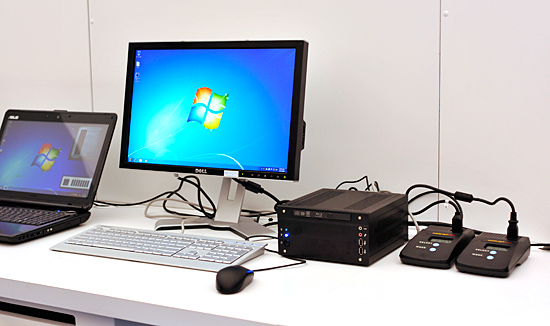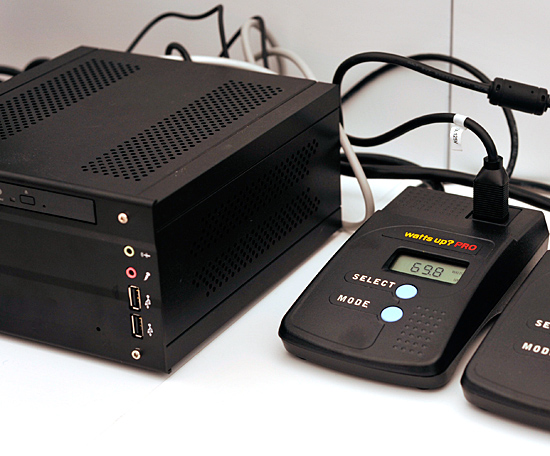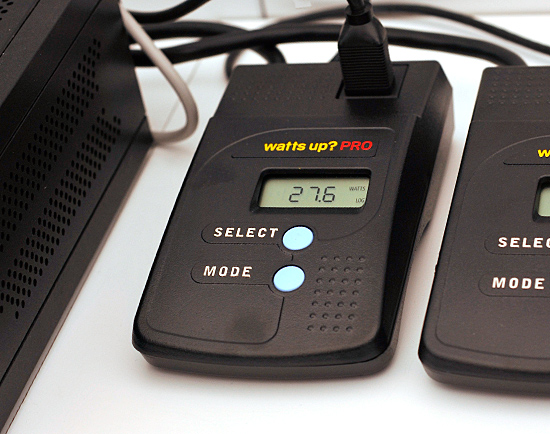The Real Conroe Successor: Clarkdale & All You Need to Know about Westmere
by Anand Lal Shimpi on September 24, 2009 6:00 PM EST- Posted in
- CPUs
Two Cores, Four Threads
Clarkdale is the spiritual successor to Conroe - one of our favorite dual-core processors of all time. It's a dual core chip but with all of the magic of Nehalem. Meaning you get a 64KB L1 per core, 256KB L2 per core but only a 4MB L3 cache. Remember that the L3 cache is shared among all cores and Intel likes to keep the ratio at 2MB per core.
Each core is capable of executing two threads (Hyper Threading). There's of course going to be turbo mode, although the upside shouldn't be too huge on desktop Clarkdale processors.

A Clarkdale mini-ITX system
Clarkdale, like the rest of the Nehalem/Westmere family makes extensive use of clock gating. You also get a ~1M transistor PCU that is in charge of keeping power consumption at a minimum. The result is a chip that truly sips power:

69.8W under Cinebench load
Intel's Clarkdale mini-ITX system used less than 30W at idle and only 70W under load running Cinebench's multi-threaded test. The idle performance is particularly impressive - that's not too far off from an Ion system honestly, but with much better performance.

27.6W at idle










96 Comments
View All Comments
Ryun - Thursday, September 24, 2009 - link
That Cinebench score doesn't look that great, though I don't know the price of Clarkdale (would this fit into the ~$50-$100 bracket?). Otherwise, I'm excited to see these processors bring on more mini-itx proliferation and they look very capable processors.It's a good thing AMD has something to combat these processors in the form of it's Athlon II X4 line. Otherwise I'd say these, not Lynnfield or Bloomfield, would be the nail in the coffin for them.
yacoub - Thursday, September 24, 2009 - link
So to summarize the Intel options for buyers: Basically Intel is going to offer the new 32nm process for super-high-end 6core setups and for HTPC-level dual-core budget systems, but the average gamer and enthusiast who just wants a middle-of-the-road, solid, high-performing cpu is going to be limited to 45nm Lynnfield P55 or an aging i7 920 on an X58 board?tim851 - Friday, September 25, 2009 - link
I'd reckon, that the entry level 6-core will be at the i7 920's price point, so that will be your sweet-spot CPU.Intel is probably pushing the Quads in the 100-200$ price segment and the Dual Cores below 100$.
vshin - Friday, September 25, 2009 - link
Gulftown will start at $1k. Lynnfield will be the only Intel option for the budget gamer market segment (<$250 CPU, <$250 video card, no SLI) until Sandy Bridge. Stay away from the X58 platform, it's a dead-end money pit.MadMan007 - Friday, September 25, 2009 - link
I reckon you need to put down the crack pipe :D There's no way Gulftown will be ~$300.yacoub - Friday, September 25, 2009 - link
Not only that but that would require an X58 platform. What if you're running a P55? No 32nm love with more than 2 cores until late 2010 if at all? :(archcommus - Friday, September 25, 2009 - link
I agree as well. Although I'm not looking to upgrade right now anyway, I, like many others here I'm sure, have a Q6600 right now. I would want my next CPU to be a quad core with HT, preferrably 32nm, and have all the latest features like turbo mode and the on-die PCIe and memory controllers. Right now that option doesn't exist. If Westmere won't have a quad core option I guess we're just waiting for a Lynnfield die shrink.srue - Thursday, September 24, 2009 - link
I agree. I just want a 32nm Lynnfield.yacoub - Thursday, September 24, 2009 - link
Poor wording. Should replace "middle of the road" with "enthusiast overclocking system" because that's what I meant. I mean the type of CPU that's under $300 but more than 2 cores - what we've been building for the past couple years - there won't be a 32nm die shrink until SandyBridge and even then it will have more on the die than just a CPU.So for those of us building a gaming rig, who would rather not pay for an extra GPU or whatever on the die that we'd just end up disabling because we have a separate NVidia/AMD GPU on the PCIe bus, there is no 32nm die shrink on the horizon aside from a 6-core X58 chip?
jonGhast - Thursday, September 24, 2009 - link
There are some rumblings that we might see bloomfield and lynnfield get 32nm shrinks around the middle of next year.No evidence or links but it's possible.